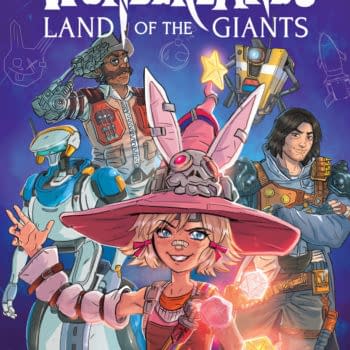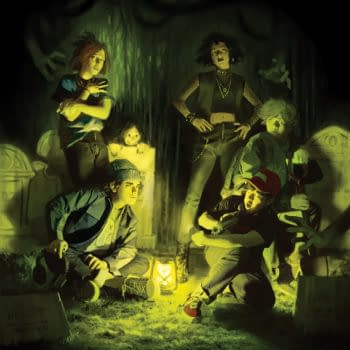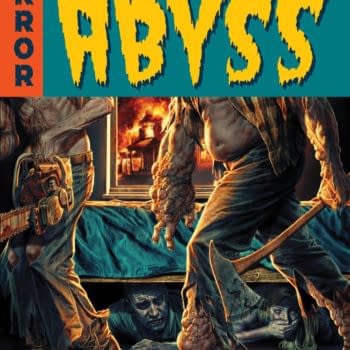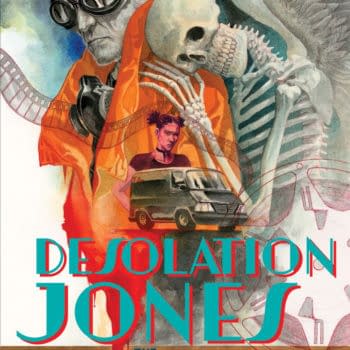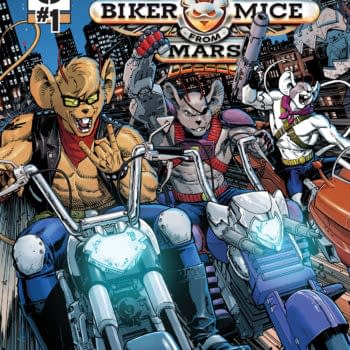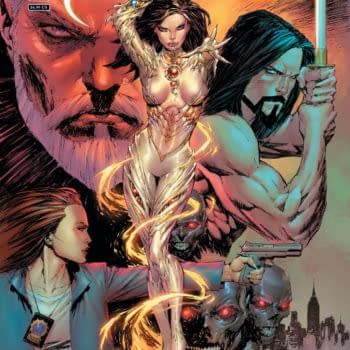Posted in: Comics, Recent Updates | Tagged: Black Dahlia, boom studios, Bryce Carlson, entertainment, Hit: 1955, Hit: 1957, james ellroy, noir, ryan sook, Vanesa del Rey
As Close To True Crime As Noir Can Get – Bryce Carlson Talks HIT 1957
This week brings the release, on April 29th of the second issue of the new series Hit 1957 from Bryce Carlson and Vanesa Del Rey at Boom! Studios. Readers have had ample opportunity to feast their eyes on the dark crime drama's previous arc, Hit 1955, and even on the special "Pen & Ink" black and white large format edition of the first two issues of that 4-part series.
Those who have read Hit 1955 or the first issue of the new series Hit 1957 always have something to say about it. It's a highly memorable book, striking in its beautiful, evocative linework from Del Rey, but also a very impactful book because it follows its characters into some very conflicted and dark places in 1950's LA, moving between the police force and underworld there. Hit 1957 introduces two main characters again, Bonnie and Slater, at a point where they are encountering new aspects of their lives and struggling with whether it's really possible for human beings to change. The Hit series occupy an important place in comic fandom right now as a blend of heightened realism with true crime sensibilities and as all new stories that follow in the footsteps of major prose and film works in the noir genre. The result is a comic that gets as close to true crime as noir can get. And that is an unsettling and impressive thing.
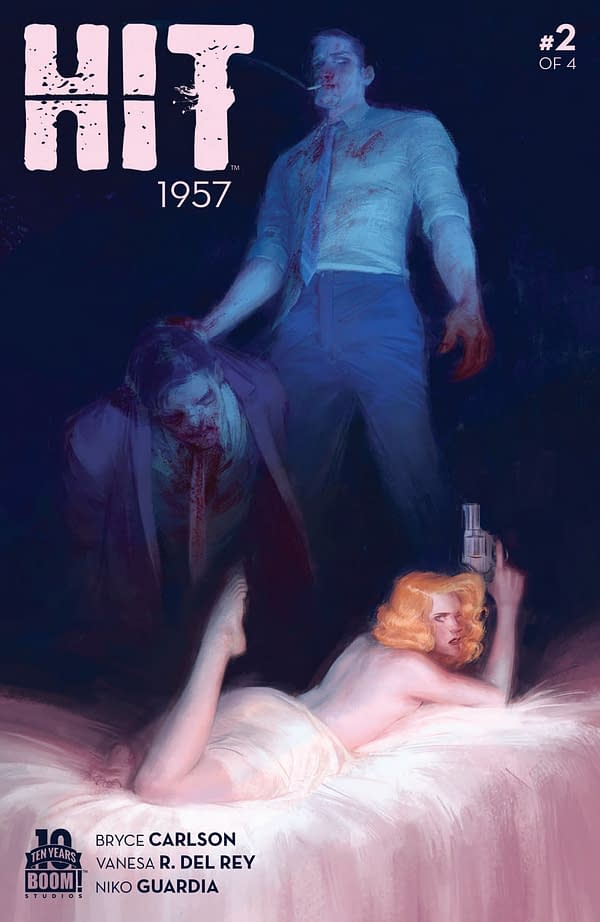
A special edition for Hit 1955 was available at Wondercon which was the "same trim size" but had a different cover, was rather lush, and had special endpapers differing from the trade. It also has an additional 16 pages on the trade in terms of backmatter, showing "cover roughs" by Ryan Sook, including ones that weren't used. They show layouts, and stages from pen and ink to color. Bryce Carlson explained to me, ahead of our interview, that their intention was to highlight the changes that occurred during the process of creation, from the first draft of scripts handed to Del Rey to the changes she might have introduced to "make a page work". It's easier for a writer to make changes to streamline a comic than the artist, Carlson said, so he's happy to do.

Bryce Carlson: I definitely try to make sure there are spots to slow down. There are places where it's very text-heavy and it's meant to read like an old crime book and have that flavor. But it's also important to let the art do its work and it changes the pacing. The common thought is that if there are no words, you go through that page really quickly, but if the art is thoughtful and well-crafted, you actually read it slower than if you had captions in every panel. In the new series there's a minimal page, a scene with Bonnie taking out some dudes with a tire iron, which might otherwise be quick, but with Del Rey's art and Aniko's color, it stands out.
HMS: There's a big color shift in that scene from issue #1, noticeably. I recall what you're talking about. You must have an affinity for the use of the narrative voice, looking at the new series, and it's a type voice which is strongly associated with detective fiction. What are your crime lit loves?
BC: James Ellroy was my introduction to the genre. Around age 11 or 12, the first time I bought a real novel for leisure, I was at Crown Books going through the shelves in the mystery section, and they had just done a new printing of Clandestine, one of Ellroy's work. I had no idea who he was at the time, and I probably shouldn't have been reading his work then, to be honest. But I fell in love with his work immediately. I still have that copy. I gave it to my wife in college and she travelled around Europe with it, so it's dog-eared to hell, but I have it. Getting into LA Confidential continues to be my favorite adaptation. Stanley Kubrik's The Killing is beautiful; I feel like I have to watch it once a year. I love everything Brubaker and Phillips do. I think they're phenomenal. There are not that many noir comics around, and that's one of the reasons why I want to do it. I know that I can't be only one out there with a hunger for it, and luckily I'm not.

BC: That's one of the things that I realized when I came back to comics after some years away, is that comics are a medium and not a genre. They aren't just the superhero comics I read as a kid. When I came back to comics, I read The Invisibles, and it blew my freaking mind. That made me get back into comics full-force. It was a revelation that you could tell stories just like a novel or a TV show in comics, but using this different medium.
I asked Carlson how much he's thinking of prose or film when composing his comics because of the subject matter and its history in those media. He explained that Vanesa Del Rey also has a very cinematic eye because she has a background in animation. He himself loves establishing shots of LA, finding it "funny" how beautiful it can look from a distance, before zooming in to a "grisly murder scene". LA is a "beautiful city with a very dark core", and that's part of his inspiration. I asked him what LA means to him as such a focus point. For me, it's traditional as a noir setting, a location I read about in crime novels myself in various locations all over the world growing up, having never been there, so my own LA is actually a crime-novel LA, imaginatively. Carlson, however, revealed, that he is in many ways a native, having grown up "LA adjacent" in Orange County, though it was still seen as an "other" place by him then.
Living in Orange County, there was a "fear" of LA, as a "dirty, dangerous" place with bad neighborhoods, particularly in the 90's. Though only a county away, there was an instilled fear of things like riots spilling over into Orange County. When he was older, and had friends in LA to visit, he fell in love with the city, but still had an awareness of danger, parking and "hustling quickly" to the door of his friend's house because it was down the street from Skid Row. Now, he pointed out, the same areas are "hip" due to gentrification. He's seen the city at its "best and at its worst", he feels. That plays into the series tagline, "Things change but people never do", which opens the new series, Carlson said.
****

BC: It plays into everything, but the focus is on the characters, Slater and Bonnie, predominantly. In the second series, he's had to take this responsibility and this mantle of his former Captain who betrayed him. He wonders, 'How long was I doing this for the wrong reasons', since he was unknowingly working for a corrupt cop. For him, the question is, can he change? He's walking the line, and he could very easily be on the good side of the line or the bad side of the line. That's his struggle in the second series, which side of the line he's going to be on. But just like in real life, whatever plans we have are affected by external conflicts that pop up. With Bonnie, she really wants to change. At the end of the first series, she disappears, and I wrote a short story about what happened to her before this series. Now she's in San Clemente and she's gotten away from all of the crazy crap that's been following her.
HMS: It appears she's won at first.
BC: But once again, you can't control what's around you and you can't get rid of your past. That's probably the biggest theme in this. Your past haunts you. You can move on, but it's still there no matter how hard you try to change. You still carry that weight with you.
HMS: The chaos of other people is part of the new series already. In lots of crime stories, it's the lesser characters who are going to have a big impact, collectively, bringing someone down who's trying to get out or get free. You can't control them or the factors affecting them in their Underworld.
BC: What's been really cool to play with in this new series are Slater, Sticky, and Haywood. Haywood is just a yes man. Sticky is the only one who fights and struggles with his conscience. In the first series, he didn't condone what was going on, but because his partner was in a situation, he goes against his beliefs because he cares about someone. Sticky's trouble is that in the first issue, he finds himself facing the consequences of something he never intended, but he has to deal with it.
I asked Carlson if he intended to use a universal theme like people not being able to really change or escape their past to help make his characters more well-rounded since it's a typical tendency in genre comics to make characters fun and stylish but end up making them to "flat". Just a reflection of popular style rather than human beings. I asked him how he counteracts this problem. He tries to bring "flourishes" to every character, Carlson said. With Slater, he's not just the cool, smoking detective. He's carrying the weight of his family breaking up, Carlson said. Carlson explained that he comes from a family with divorce and had some hard times, so he has been able to draw on that to give Slater "interesting subtext" and keep him from just being a "cool, hard-nosed detective" which can be fun but lacks depth. Carlson finds it "more interesting" to see how his "cool, grey character" Slater got that way. Hit 1957 concludes that "backstory arc" about Slater, and warned that the series is a "dark journey" for Slater.
Carlson said that he's aware that for many people the two Hit series, 1955 and 1957, are too "dark", and people who aren't fans of crime fiction probably won't "dig it" as much. It's not a "hopeless" story in 1957, but it's "not full of rainbows and sunshine" he explained. "This is a story that is about those dark crevices in our lives that we sometimes try to hide away", he said, "This is a chance to shine a light on it". I asked Carlson what his personal motivation is, as a writer, and as a person, in doing so, whether it gives him more insight into human beings, or whether it has some kind of therapeutic value for him as well as for the reader. He said it's an "amalgamation" of reasons, including "working out stuff on the page personally". Sometimes it's just about "exploring" the "unfamiliar" and challenging himself. Sitting in a room alone working, "seeing" what's happening to the characters does definitely "affect" him. After writing Issue #3, he was "physically exhausted, physically affected" by it in a new way, and he took that as a sign that he had managed to enter "uncharted territory". He thinks that the next series he works on will probably not be as "dark" as Hit.
There are many "places in the human psyche" Carlson still wants to visit. But he's not going to be working on anything else until the 4 issues of Hit 1957 are done, given his editorial duties as well. And even after the single issues are out, there's the compilation of a trade necessary with extra material. The Hit team will be doing another "Pen and Ink" large format edition of Hit, including 1955 Issues #3 and #4 this June with extra commentary material, which will take time and attention. These large editions are at 11×17 in size, black and white, and contain extra commentary by Carlson and Del Rey. Carlson explained that they "go page by page" afterward for the commentary, but it's very much about the artwork, throwing in some "personal Easter Eggs" like place-names. It allows the book to be "read in a different way", and the pen and ink version makes that easy. Carlson feels that it really shows off Del Rey's artwork, since there are few artists where seeing their work in black and white shows that it is just as strong.
I asked Carlson about coming to work with Del Rey, and he said that a Boom editor found her online, and the first material they'd seen from her were "cool noir pages". It was "love at first sight" for Carlson. I asked what in her background or interests made Del Rey so interested in noir, and Carlson said that when he finally met Del Rey in person, he learned that she was born and raised in Cuba. She told him that because of this she finds it very "easy" to "do 50's LA" because that's the way that Cuba looked to her growing up. Carlson was always sending her reference that she didn't really need, since she has such an ability to render an "authentic" feel.
****

BC: (Laughs) There are no immediate plans. I have ideas for what could come next, and what I would like to do if that opportunity presented itself, but I'm waiting to see how the series goes. You have to make sure there's a readership and the market is responding. If there is, I know what I would do. But if there's not—and I did the same thing with the first series—I write it like I'm not going to be writing it again.
HMS: That seems like it's always the best option for writers, artists, what have you. You never know what's going to happen tomorrow so create what you want to create right now.
BC: Matthew Weiner talked about this in an interview recently, and I'm paraphrasing, but he says that he writes every season of Madmen like it's the last.
HMS: Every episode has that weight of dread too! Like it is the last!
BC: He says, "I have to put it all in". I couldn't agree more. I don't ever want to be in a position where I say, "Ah, man I didn't get that next arc. I really wanted to do this thing".
HMS: The only other major topic I was wondering about concerning Hit was the extreme violence we see in the series. But, honestly, it seems like almost par for the course for this kind of subject matter. I read quite a few comics, and crime and noir stories are usually very violent in their depictions. Occasionally creators shy away from showing it as directly as you all do, however. What are your thoughts on that?
BC: It does play a big part of the series. It goes back to exploring a dark time. If you go back and look at the photos from the Black Dahlia murder scene, they are horrific.
HMS: Yep. True crime is this bad.
BC: Exactly. That is real life, things that are happening to real people. I feel like I wouldn't be doing the era and the genre justice if I was trying to change it because I don't agree with the behavior. I don't believe in murder. It's just the reality of the story.
I didn't make all this up—it's all based on things that have existed in our society beforehand. It's art of the real world, and maybe that's too real for some people.
I follow some LA Police Scanner Twitter accounts, as well as LA Times and local news, and so much stuff happens on a daily basis that no one talks about. I have to distance myself, to a certain extent, from the every day, working on this book, like the state of police brutality in the current climate. How do you compartmentalize that? All that is happening while I'm writing this book.
Carlson and I talked about being a "research obsessive" and how you can fall into your research. He never wants a reader to have an excuse to feel "distracted" by a lack of authenticity, because all it takes one slip up on the model of a car based on the date of the story to destroy the illusion of reality. Fortunately, the 50's are a very "well documented decade" for Carlson, and he loves going through the advertisements, photos, and magazines. Carlson sent Del Rey two books, Los Angeles: Portrait of a City, from Taschen, and the new Art of Robert McGinnis, someone who was a wide-ranging pulp cover artist as well as movie poster artist who ranged from James Bond to crime images, to feast on.
Talking with Bryce Carlson about his work on Hit 1955 and 1957 was a pleasant oasis in the midst of busy WonderCon and took me on a tour of his perception of noir that was truly rewarding for me, as a longtime fan of the genre. Look out for some more gorgeous artwork and psychological scrutiny of characters living life on the edge this week in Hit 1957 #2.













